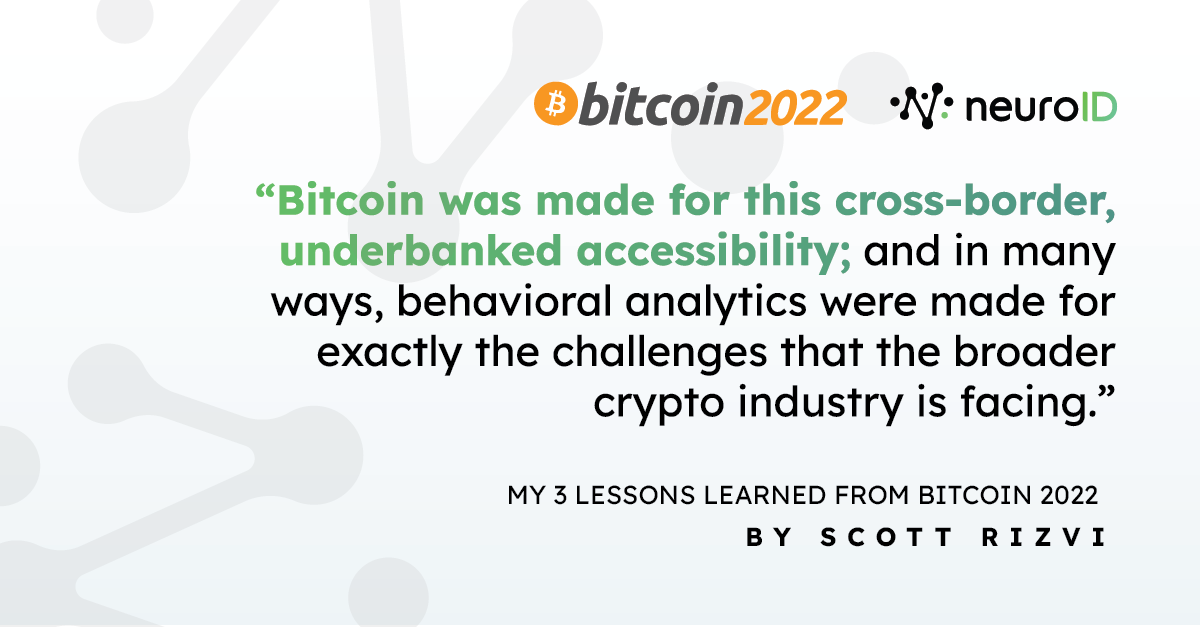
My 3 Lessons Learned from Bitcoin 2022
I had the pleasure of attending the biggest crypto industry event this year: Bitcoin 2022 in Miami, Florida. I spent four days talking to industry leaders, practitioners, investors, and other major players throughout the crypto ecosystem. I learned a lot about where Bitcoin and the broader crypto industry is going, its core challenges, and how behavioral analytics can help redefine the crypto-game.
The overall theme through all these conversations: even as crypto grows in leaps and bounds, onboarding users safely and securely is a major roadblock. Here are the three biggest topics I came away thinking about after almost a full week of conversations.
1: Interest is growing, and so is the industry.
The conference was way bigger than it was last year, and you could feel that energy was in the air. There’s a lot of growing interest in how to enter, own, and capitalize on the Bitcoin and cryptocurrency ecosystem, from investors and leaders alike. The conference itself was a day longer, and had almost twice as many attendees (up 12,000 last year to more than 30,000 people this year, according to conference organizers), and from the folks I talked to, it could have gone on even twice that long—there’s that much buzz around the industry right now. It’s clear that there’s a digital asset revolution underway.
2: As more doors open for crypto, crypto itself is opening new doors.
Bitcoin is most valuable to traditionally global underbanked areas. At this conference alone I talked to attendees from El Salvador (where crypto is now legal tender), Kenya, Turkey, India . . . the list goes on and on. Bitcoin and other cryptocurrencies are especially attractive to these regions because they don’t have a lot of financial infrastructure. But that also means there’s not a lot of publicly available information—or personally identifiable information (PII)—accessible by the typical fraud stack identity checks. Something like document verification (where a user is asked to take and upload a photo of their driver’s license, for example) to verify identity at account opening is also a roadblock, as technology itself lags: low bandwidth, lack of smartphones, etc. can all lock out these customers right at onboarding and introduce high levels of friction for the underbanked markets that have the biggest need and business opportunity.
3: Bitcoin spans borders—and so does behavior.
Along with the rest of my NeuroID colleagues, I’m on a mission to solve the Digital Identity Crisis. So of course, when I hear the message that Bitcoin is accessible across borders as a universal currency, my mind makes the connection to our NeuroID behavioral analytics—another universal language.
Behavioral analytics and digital body language know no borders. We all act the same when we are familiar with our PII, and have the same tells when we’re unfamiliar with our PII. Bitcoin was made for this cross-border, underbanked accessibility; and in many ways, behavioral analytics were made for exactly the challenges that the broader crypto industry is facing. Crypto companies trying to use credit bureaus or historical consortium data are dependent on how much data that fraud vendor has on different areas of the globe. At NeuroID, we give you one authoritative solution, with universal translatability.
Stay Ahead of Where Crypto Goes Next
Crypto will continue to grow and change. Behavior is a constant. Sign up for a demo to learn how behavioral analytics can overcome the challenges of this high-growth, highly vulnerable market.



